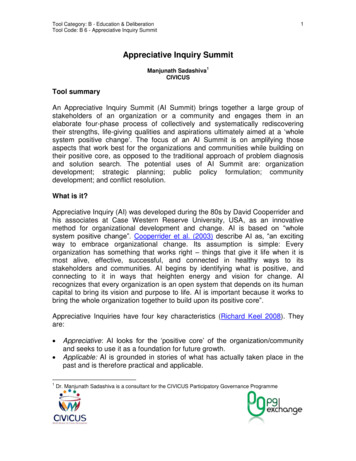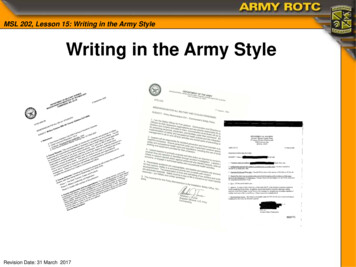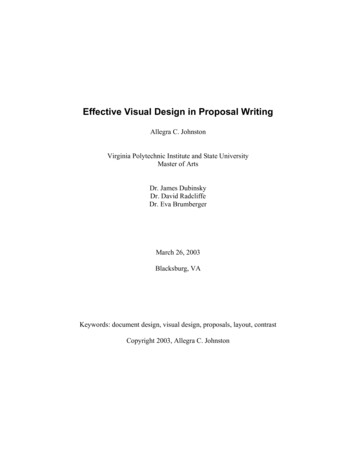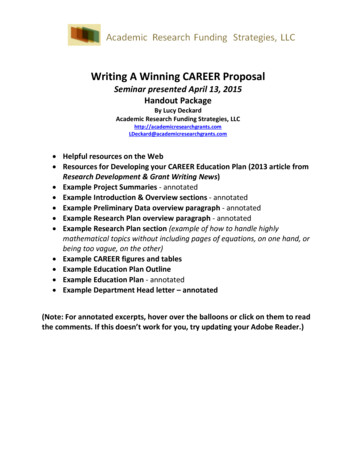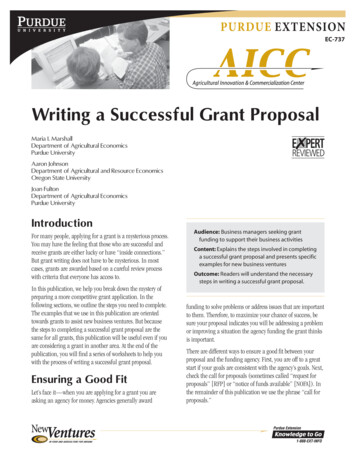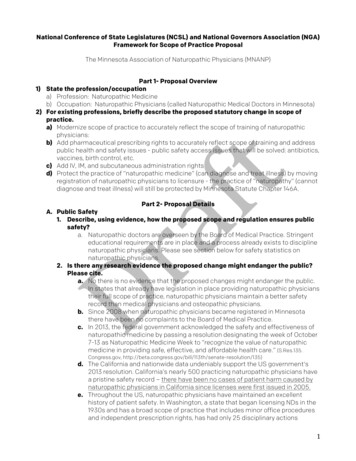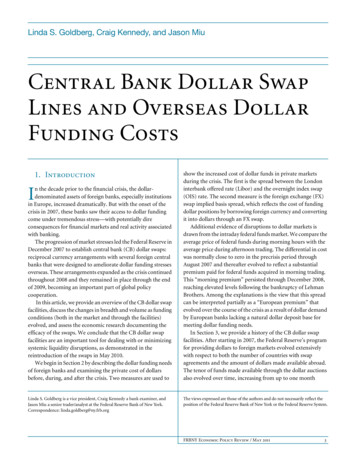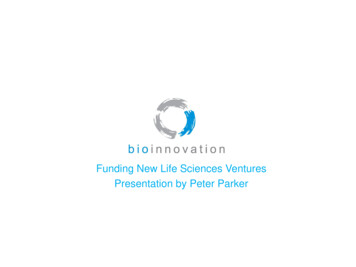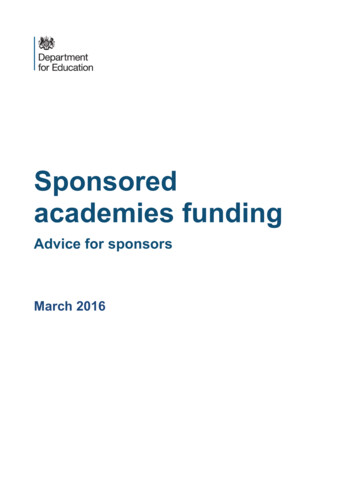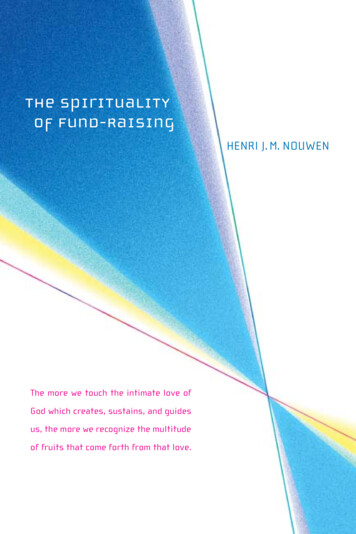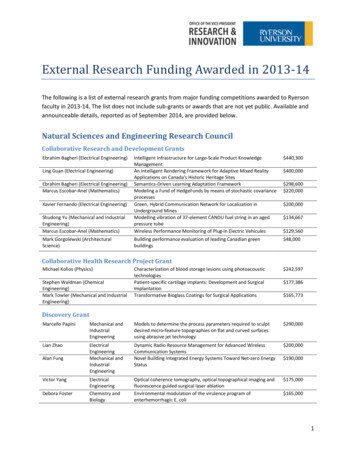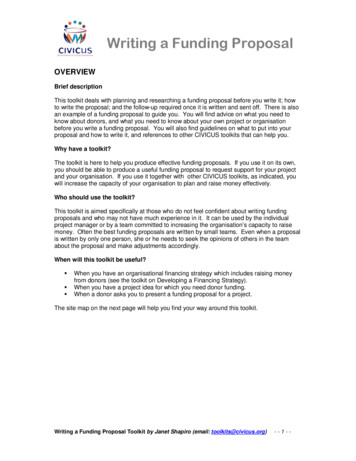
Transcription
Writing a Funding ProposalOVERVIEWBrief descriptionThis toolkit deals with planning and researching a funding proposal before you write it; howto write the proposal; and the follow-up required once it is written and sent off. There is alsoan example of a funding proposal to guide you. You will find advice on what you need toknow about donors, and what you need to know about your own project or organisationbefore you write a funding proposal. You will also find guidelines on what to put into yourproposal and how to write it, and references to other CIVICUS toolkits that can help you.Why have a toolkit?The toolkit is here to help you produce effective funding proposals. If you use it on its own,you should be able to produce a useful funding proposal to request support for your projectand your organisation. If you use it together with other CIVICUS toolkits, as indicated, youwill increase the capacity of your organisation to plan and raise money effectively.Who should use the toolkit?This toolkit is aimed specifically at those who do not feel confident about writing fundingproposals and who may not have much experience in it. It can be used by the individualproject manager or by a team committed to increasing the organisation’s capacity to raisemoney. Often the best funding proposals are written by small teams. Even when a proposalis written by only one person, she or he needs to seek the opinions of others in the teamabout the proposal and make adjustments accordingly.When will this toolkit be useful? When you have an organisational financing strategy which includes raising moneyfrom donors (see the toolkit on Developing a Financing Strategy).When you have a project idea for which you need donor funding.When a donor asks you to present a funding proposal for a project.The site map on the next page will help you find your way around this toolkit.Writing a Funding Proposal Toolkit by Janet Shapiro (email: toolkits@civicus.org)--1--
Writing a Funding ProposalOVERVIEWBASIC PRINCIPLESBEST PRACTICERESOURCESPage 1pp.3-27pp.28-37Page 38GLOSSARY OFTERMS p. 39ExampleBefore you write p.3The Proposal p.17Body of proposal/ContentsWhy? Forwhom? p.4StructureChoose thedonor pp.7-9Know yourselfpp.10-12Follow-up p.25pp.18-22Conclusion &BudgetKnow the donorAppendicesYour identityBibliography/ReferencesSWOTTrack recordFollow-up proposalp.25Follow-up grantp.26Do’s andDon’t’s p.23ContentPlan theprojectObjectivespp.13-16ProcessWriting andlayout tips p.242
Writing a Funding ProposalBASIC PRINCIPLESBefore you writeThe best advice we can give you is:Don’t start writing a funding proposal before you have done the necessary research, thinkingand planning!Why do you think this is so?The funding proposal forms the basis of your relationship with a donor. If the donor can seethat it is hastily written, without careful thought and planning, the relationship may be a veryshort one! Rather give the impression, based on fact, that you are thorough, careful andcommitted to doing a good job, right from the start.In this section of the toolkit we deal with the tools you need before you begin writing theproposal.If possible, you need to begin preparing at least a month before you want to submit a fundingproposal. As you will see, there is a lot to do and you need time to do it properly.Before you begin writing, you need to: Be clear about why and for whom you are writing the proposal.Understand the donor for whom you are preparing it (See the sections on Choose theDonor and Know the Donor).Know yourself, which means being clear about your identity, knowing your strengthsand weaknesses (look at the section on the SWOT Analysis), and being able topresent a credible track record in areas such as financial management, projectimpact, technical competence and general management ability.Finally, you need to plan the project, which means understanding the context, settingobjectives, and designing a process.All these areas are dealt with in the pages that follow.3
Writing a Funding ProposalWhy? For whom?The first question you need to ask yourself is: Why are you writing a funding proposal?The simple answer to this is:You write a funding proposal to persuade someone to give your organisation or projectmoney. The chief purpose of a funding proposal is persuasion, NOT description. So, whileyou will need to describe the proposed project, you need to do so in a way that will convincea donor to give you money.There are several reasons why you may have decided that the best route to go in raisingmoney for your project is through “selling” it to a donor. These might include: Large sums of money are needed;You have decided that it is important to “diversify” your funding base – to have morethan one or a few donors who support your organisation;The proposed project fits within a broader framework of regional or nationaldevelopment in which a number of donors are already involved.Before you go ahead, be sure that requesting funds from a donor is a good route to go forthis particular project. Alternatives include: Raising money from the community which will benefit;Using money which the organisation has generated itself through investment orearned income.(For more on alternatives to fundraising, you should look at the toolkit on Developing AFinancing Strategy.)Who are you writing the proposal for?There are two levels at which this question can be answered: “Who” meaning what kind of funding agency do you have in mind?“Who” meaning what sort of person is likely to read it?Different kinds of funding agencies:(Further on in the toolkit you will find a table of types of agencies and the advantages anddisadvantages of each type.)Why is it helpful to think about the different kinds of funding agencies?Because you will be able to match the project you have in mind to the interests and concernsof each agency, and the amounts of money that each agency is likely to have available. Youwill also be able to anticipate some of the problems that may occur.If you do not have much experience, it can be useful to speak to other civil societyorganisations about their experiences with different kinds of agencies.4
Writing a Funding ProposalType of agencyGovernmentAdvantages Churches Large family foundations Small family foundations Major corporate funding Small corporate funding DisadvantagesOften have a lot of money.May be useful on issues ofpolicy, access etc.If project fits governmentstrategy, this increasespossibility of meaningfulimpact. Often share thedevelopment and ethicalagenda of progressive civilsociety organisations.Usually have quite a lot offlexibility in what and howthey fund. Have large sums of moneyto give.Staff are professional,understand the issues andcivil society concerns.Clear guidelines on what isfunded and the process forgetting funding usuallyprovided.Willing to shareinternational experience.Often form closerelationships and have apersonal commitment to anorganisation.More flexible on format andprocess.More flexible on what theyfund.Have large sums of moneyto give.Often have professional,accessible staff.Usually clear on what theywant from the arrangement.Not a hidden agenda. Informal approach.Interested in local projects.Personal connections veryhelpful.Agenda usually clear. Process of application isoften bureaucratic andtakes a long time.Payment is often delayedand there is very littleflexibility.Application requirementscan be complex.Usually rely on ownconstituency to raise moneyand this means that fundsmay be limited and/orsubject to fluctuations.Sometimes get allocationsfrom governments and aresubject to changes ingovernment policy.Process for application canbe lengthy.Requirements forapplications can becomplex.Priorities may change.Staff not always asprofessional as that ofbigger foundations.May not have much money.Personal contacts veryimportant (can also be anadvantage).Change priorities quiteoften.Sometimes want directrepresentation on theboard.Often very sensitive toanything that might alienateother stakeholders.Not that much money.Interests limited.If no personal connections,no funding!5
Writing a Funding ProposalWho is likely to read your proposal?Remember what we have already said - that you are writing the proposal to persuadesomeone to give you money for your project.But who is the ‘someone’?Usually, there are two kinds of people who could read your proposal: The decision-maker who will make the final decision, based on your proposal.Sometimes there may be more than one decision-maker, with someone at a projectofficer level making the initial decision to support the proposal and someone at amore senior level, or a committee, making the final decision.A technical expert who will assess the technical competence of the proposal andwrite a report to the decision-maker(s) but not make the decision.This should tell you that your proposal must be: persuasive; andtechnically detailed and correct.In the section dealing with The Proposal, we suggest that, in order to keep the body of theproposal a reasonable length, you include the technical detail as one of the appendices.6
Writing a Funding ProposalChoose the donorWe have already discussed the different kinds of donors (in the sections Why? and ForWhom?). If you are interested in local donors, you need to do some research to find out whoin your area gives money to the kind of project you are “selling”.To make an informed choice about the right donors to send your proposal to, you need toknow something about the possible donors. Different donors have different interests.Approaching the wrong donor with a request wastes both their time and your time.In order to prepare a good proposal, a proposal that gets the results you want, you need toknow even more.Know the donorThere are two aspects to what you need to know about a donor: You need an understanding of what the donor wants in terms of goals, mission,concerns; andYou need to know the practical details of format, timing etc.Remember that writing a funding proposal is a “selling” process. As anyone in the retailbusiness will tell you, when you sell something, you need to know what the prospectivebuyer wants. Donors are “buyers” and they have an agenda and are entitled to have anagenda.What do donors want?Most donors want a range of things. These include: To make an impact or a difference – they want their money to count, they want thework they fund to be successful, they want to be seen to be successful.To acquire knowledge, understanding, information.To share knowledge, understanding, information, and, in so doing, add value to theirchosen interventions.To increase their influence in addressing what they consider to be the problems ofthe world, the region, the country, or a particular area.What does this mean for you when you are preparing to write a proposal?It means firstly, and very importantly, that your overall agenda cannot be too different fromthat of the donor. If your organisation supports the legalisation of abortion, it does not makesense to send a funding proposal to a pro-life church donor.It also means that your proposal must convince the donor that supporting your project islikely to lead to a successful intervention, one it can be proud to claim involvement with, andone the donor, and those the donor wants to influence, will identify with. People identify withpeople. This means that, when you write your proposal, it must have a human quality. Itshould not just be a dry summary.7
Writing a Funding ProposalMost donors will also want to feel that they can add value by sharing what they have learnedfrom other projects and interventions with which they have been involved. To a greater orlesser extent, this means that they will “specialise” and will want to fund projects that fitwithin their specialisation.The more you know about a donor, the more you will be able to choose the donors who areright for you, and the more you will be able to present your proposal in a way that makes thedonor want to “buy” it, or buy into it.The packagingWhatever the donor wants, it wants it well-packaged. This means getting the presentationright as well. Once you have decided that your goals and concerns fit those of the donor,then you need to know what the donor wants in terms of packaging. This includes knowingwhat format it wants its proposals in, what details it wants included, whether it uses a specialplanning format, such as logframe analysis (see Glossary of Terms), how long it expectsproposals to be and so on.In summary, this is what you need to find out about a donor: Name, address, telephone and fax numbers, e-mail address, name and title of theperson you should make contact with. This is the preliminary information which you canget from the switchboard, from the donor’s web page, from a directory, or from yourcolleagues in civil society organisations. The goals, mission and concern of the donor, including its areas of interest, whether itfunds in particular geographical areas only, what its general funding criteria are, whatelse it funds. You can get this kind of information from a web page or from a brochure orannual report, as well as from your colleagues in civil society organisations. What size of grant the donor usually gives. What the donor’s decision-making process is and how long it is likely to take for adecision to be made once you submit a written proposal. The dates when proposals are considered and the dates/deadlines for submission ofproposals for consideration. Whether the donor has a special proposal format you should use, or guidelines youshould follow, or whether you can use your own. Some donors may want a shortpreliminary proposal before asking you to complete a full proposal. This enables them tomake an initial judgement about whether or not they want to get involved in moredetailed negotiations with you.All this information is best obtained from the appropriate desk officer or project officer. Youneed a name, a person to whom you can speak, either by telephone or in a preliminarymeeting. This initial contact is very important. It can set the tone for the whole relationship.8
Writing a Funding ProposalThe personal contactIt is always important to remember that “the donor” is represented by people – the deskofficer, the project officer, the regional CEO – these are people with concerns, interests, andenormous demands on their attention and time.What does this mean for you?It means that: You must communicate professionally with the donor representatives. Do so withpurpose and do not waste their time.You must be honest and open when you communicate. Be prepared to listen and toshare information and ideas.You must project the human side of your work so that the donor is able to identifywith people at a human level.In summary, then, the time sequence is: Make some general inquiries about appropriate donors.Follow up by making contact with a project or desk officer.Begin work on the planning stage of your proposal.However, there is one important aspect we have not yet dealt with and which you need toaddress even before you make the initial contact with the desk or project officer. You needto be sure that you know yourself. That is what we deal with in the next section.Why do you think it is important to know yourself and to be confident that you can project agood image of your organisation before you speak to the project or desk officer?Because the buyer has to believe in the salesperson!9
Writing a Funding ProposalKnow YourselfWhat does it mean to “know yourself” before you write a funding proposal?It means that you cannot hope to “sell” or promote a project if you do not know, and cannotpresent, a picture of your organisation as a “good risk”Many organisations and projects make requests for money from donors. The donors’business is, in a way, giving away money, or put differently, investing in development or aidof some sort. When a donor makes this kind of investment, it looks for a “good risk”, aproject or organisation that is likely to make a difference, and to sustain an intervention.Knowing yourself in such a way that you can project a credible picture to possible donors isnot something that happens overnight. It is an ongoing part of building your organisationalcapacity.When you sit down to write your funding proposal, you already need to know, and havewritten down: Who you are, what your identity is. What your strengths and weaknesses are, and what opportunities and threatsconfront you (you need, in other words, to have done a SWOT Analysis, and this is aformat to help you with this on the best page). Your track record (what you have achieved and what you can show from past workthat will give a donor confidence that you are a “good risk.”All these areas are dealt with in the next section of the toolkit.Organisational identityTo present your organisational identity, you need: An overall mission and goal for the organisation – why it exists, who it is intended tobenefit, how it is linked to the intended beneficiary community and what it is committed toachieving through its work. (There is more on this in the toolkits on Planning). It is useful if the organisation also has a visible and recognisable identity in the form of alogo, but this is not essential. A council or board that provides the organisation with a credible governance structure.This means that you need a short biography of each person, reflecting, for example,such factors as experience, community links, gender and an appropriate racial mix.Some organisations also have patrons. These are usually highly respected and wellknown people who, although they do not have the time to be involved in the regulargovernance of the organisation, are willing to lend their support and name to the causeand the organisation. Key staff or volunteers who are in place to make the organisation and, therefore, theproject, work. Here too you want to present brief biographies of the people who will becentral in the project, showing why they are appropriate.In summary, you need to present yourself as a sound, accountable organisation, competentto achieve its objectives.10
Writing a Funding ProposalDoing a SWOT AnalysisA SWOT Analysis is a simple planning tool that will help you to identify the strengths andweaknesses of your organisation, as well as the opportunities and threats facing it. Havingdone this, when you write your funding proposal you will be able to show how you will buildon your strengths, address your weaknesses, use the opportunities and confront the threats,through the proposed project. In this way, you will show the possible donor that you have arealistic and accurate picture of the organisation, and that you have the insight anddetermination to build its capacity to ensure that the project will be sustainable.Remember that strengths and weaknesses refer to internal factors while opportunities andthreats refer to external factors. So, for example:A strength might be:Experienced and committed staffA weakness might be:Insufficient technological skills among the staffAn opportunity might be:Government policy supportive of the kind of work theorganisation doesA threat might be:Current donors have changed their focusIt can be helpful to do a table that looks like g through these issues with your staff will also give them the confidence to promotethe organisation and project.11
Writing a Funding ProposalKnow and record your track recordRemember that, if a donor decides to support your project, it is taking a risk, so you must beable to present evidence to show that it is a “good risk.”The following are common areas in which you should be able to present such evidence: Previous results and impact. Good management competence with regard to projects and people. Good financial management skills and skills in drawing up a financing strategy
Writing a Funding Proposal 2 OVERVIEW Page 1 BASIC PRINCIPLES pp.3-27 BEST PRACTICE pp.28-37 RES OURCES Page 38 GLOSSARY OF TERMS p. 39 Example
